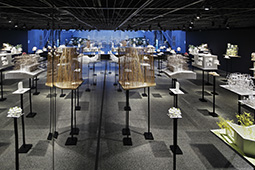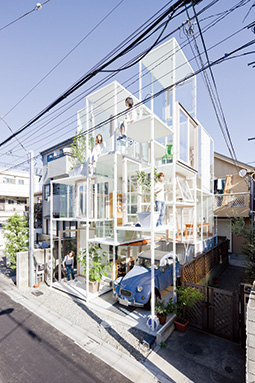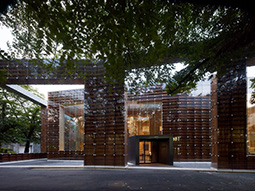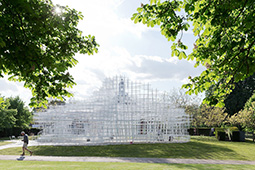Home > Highlighting JAPAN > Highlighting Japan November 2017 > Architects of Japan: Building the Future
Highlighting JAPAN

CREATING FUTURES OF THE FUTURE
Japanese architect Sou Fujimoto is making waves overseas with designs that anticipate the future, inspiring viewers to imagine their own individual futures.
Born in 1971, Sou Fujimoto is an award-winning architect whose designs have been exhibited and realized around the world. In 2000, the young architect created a stir by winning second place for his proposal for the design of the Aomori Museum of Art, an international competition that attracted 393 entries. Since then, Fujimoto has been involved in more than 100 projects, from housing to public structures, and has won numerous prizes, including (with Toyo Ito [see here]) the Golden Lion for Best National Participation at the 13th International Architecture Exhibition, Venice Biennale in 2012, for the Japan Pavilion. In 2014 Fujimoto was named Wall Street Journal’s “Architecture Innovator of the Year,” and in 2015 he won the international design competition for his firm's undulating, “sound waves-inspired” proposal for the House of Hungarian Music in Budapest.
In November 2017, Fujimoto’s “Sou Fujimoto: FUTURES OF THE FUTURE” exhibition will begin a tour of the JAPAN HOUSE facilities in Sao Paulo (see here), Los Angeles and London, spending approximately three months at each venue. The exhibition, which was selected through an open application process, reprises the exhibition of the same name that was held at TOTO GALLERY • MA in Tokyo in 2015 and which attracted many visitors.
Based on Fujimoto’s desire to exhibit his ongoing trial-and-error models for the future as well as his major works from the past and ongoing projects, the 2015 exhibition traced the history of his creative activities and the process of his thoughts. Some 111 architectural models were arranged at random at the venue and fascinated visitors as “a forest of models.”
Of the exhibition’s title, “FUTURES OF THE FUTURE,” Fujimoto explains, “Individual architectural structures that we continue to create are, so to speak, small dots. Although they are small dots, they contain wishes for the future. When people see these small dots, they begin to imagine their future. In this way, these small dots become a series of countless inspirations and will ultimately create a real future.”
Fujimoto adds, “I think that architecture and creation are all about planting seeds of the future. These seeds of the future bud with the imagination of many other people, grow and become new seeds of the future. I came up with the title ‘FUTURES OF THE FUTURE’ by imagining these chains of creativity.”
Fujimoto’s architecture, exemplified by houses such as “House NA” and “Tokyo Apartment” and public structures such as “Musashino Art University Museum & Library” and “Serpentine Gallery Pavilion 2013,” is like the sky, forests and wind. It naturally integrates with its surroundings, makes mysterious connections and new spaces, and inspires visitors to feel as if they are looking at the future.
In the JAPAN HOUSE exhibitions, Fujimoto will again exhibit numerous architectural models, inspiring visitors to imagine their own immediate futures.
“A model is a piece of thought and an inspiration of the future,” he says. “Unlike completed architecture, architectural models are beginnings that are filled with infinite possibilities. By exhibiting numerous models, I expect visitors to discover and enjoy the possibilities within the models and begin to imagine the future. I suppose that infinite futures will be born from there and infinite futures will talk, which leads to a rich future.”
Fujimoto adds, “Architecture is about creating places for people. I believe that the architecture of the future should create a place where people feel a sense of freedom more strongly, where people feel that both individuals and communities are precious, where people feel that the world is enjoyable, where people feel that the diversity of the world is wonderful and where people feel that they will be able to choose and create the future by themselves.”
For Fujimoto himself, the future involves continuing to create great architecture, and the future of the future involves continuing to present possibilities and “pieces of thought.”
© 2009 Cabinet Office, Government of Japan










